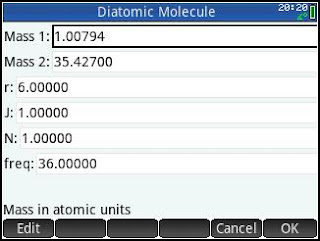Generating
Permutations: TI-84 Plus, Casio Prizm,
and HP Prime
In combinatorics, a permutation is an ordered arrangement
of numbers, typically 1 to n. For n = 3,
there are 6 (3!) possible permutations:
{1,2,3}, {1,3,2}, {2,1,3}, {2,3,1}, {3,1,2}, and {3,2,1}.
This blog will focus on generating a random permutation
given n elements.
TI-84 Plus: Using the randIntNoRep function.
For the TI-84 Plus, generating a permutation is rather
simple with the randIntNoRep (random integers no reputation function). The syntax to be used is:
randIntNoRep(1,n,n)
For n = 3, the syntax would be randIntNoRep(1,3,3). You can find this function by pressing [math],
PROB submenu, selecting option 8.
For the Casio Prizm and the HP Prime, a program will be
needed. I gave the program the title SAM
for sample (no repeating numbers).
Generally, SAM uses two lists. The
first list is generated by a sequence from 1 to n. The second is rearranged list. In order to get sample to not have repeats,
during the main loop, as numbers are picked, they are replaced by 0. During subsequent picks from the first list,
the loop tests to see for a nonzero list.
The second list is the output.
Note that with the Casio Prizm that lists must have at
least one element to be initialized, where the HP Prime allows for blank lists
(lists with zero elements).
Casio Prizm: SAM
“N”?→N
Seq(x,x,1,N,1)→List 1
RanInt#(1,N)→C
List 1[C]→M
{M}→List 2
0→List 1[C]
1→I
Do
RanInt#(1,N)→C
List 1[C]→M
If M≠0
Then
Augment(List 2,{M})→List 2
0→List 1[C]
1+I→I
IfEnd
LpWhile I≠N
List 2
HP Prime: SAM
Input: SAM(n)
EXPORT SAM(n)
BEGIN
LOCAL s,L0,L1,I,c;
L0≔MAKELIST(X,X,1,n,1);
L1≔{ };
I≔0;
REPEAT
c≔RANDINT(1,n);
IF L0(c)≠0 THEN
L1≔CONCAT(L1,{L0(c)});
L0(c)≔0;
I≔I+1;
END;
UNTIL I==n;
RETURN L1;
END;
Update: Changing c:=RANDINT(n) to c:=RANDINT(1,n) forces the random integer function to choose a number between 1 and 0, since RANDINT(n) allows for zero, allowing for a number to repeat, which is what we don't want. Eddie
Note: This is
different from the permutation function (nPr, PERM) on your calculator, which calculates
the number of arrangements of r from
n objects. (Formula: n!/(n-r)!)
Eddie
This blog is property of Edward Shore, 2015.













